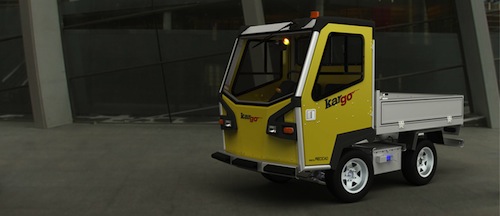
The Kargo is half the weight of the previous steel utility transport with nearly 80% fewer welds. Image Courtesy of Services Précicad Inc.
Latest News
August 29, 2014
It only stands to reason that an aluminum smelter in need of utility vehicles for operations and maintenance would want those vehicles to be made out the same aluminum it manufacturers, not steel.
Manufacturing a structurally-sound utility transport out of a wholly new material wasn’t the only design challenge for this effort, put into play by Aluminerie Alouette, a Canadian aluminum smelter. The new design also had to accommodate an electric power train—a requirement because the smelting process creates such a strong static magnetic field that regular internal combustion engines have a hard time operating properly within that environment. The third requirement was to create a vehicle design that would allow for easy recycling at the end of the transport’s lifecycle.
The design challenge was handed to Services Précicad, a multidisciplinary, product development consulting firm, which had worked with Aluminerie on other projects. “They thought it would be fun to showcase the material they were producing,” explains Stephan Lachevrotiere, Services Précicad‘s head of design. “Also, by its nature, aluminum is three times lighter than steel. Not having as much of a payload to run around is beneficial for an electric car, giving the batteries a longer lifecycle.”
Services Précicad was given a year to come back with the aluminum-based transport design, but was able to develop and deliver the first prototype to the smelter plant in just 10 months. Key to its ability to beat delivery targets was the use of finite element analysis (FEA) as part of an integrated design and analysis process, an approach that substantially cut back development time.
The team used Dassault Systemes’ SolidWorks CAD software to model the vehicle geometry and then leveraged NX CAE tools from Siemens PLM Software, including NX Nastran and NX Thermal Software for FEA, to do the simulation work. The team opted for the Siemens NX analysis portfolio because of its specialization in Nastran, and there were no problems integrating the CAD geometry with the FEA meshing tools despite being from competing vendors.
NX’s Synchronous Technology feature was tapped to simplify the geometry before creating the finite element mesh. It also enabled the engineers to make geometry modifications working directly with the NX analysis model, which let them avoid going back and forth between the simulation software and SolidWorks.
“With this kind of technology, we were able to do things like meshing much faster and it saved us a lot of hours because we had simplified models for FEA analysis,” noted Stephane Arsenault, head of Services Précicad’s FEA department.
The primary role of the FEA tools was to ensure the aluminum-based vehicle would be as structurally sound as its steel predecessor. Aluminerie Alouette had requested a load-carrying capacity of 1,000 pounds, and the FEA tools were used to explore load conditions like gravity, braking, turning and acceleration. The final design of the vehicle, now called Kargo, weighs only 1,500 pounds, which is half the weight of the company’s earlier steel-framed vehicles. The Kargo, in its third iteration, can now handle a 1,500-pound load.
In addition to the substantial weight loss plan, the Kargo also made strides reducing production costs. The original steel structure was welded, thus very costly to produce. With the help of FEA, Services Précicad was able to design its own aluminum extrusions and simplify its parts resulting in a reduction in the number of welds by nearly 80%.
Even better, with fewer welds and more mechanical connections, the Kargo is now easily dismantled for recycling.
“This is one of the first vehicles of its kind that is 100% aluminum,” Lachevrotiere says. “To be able to produce an eco-friendly vehicle that does the same job as the steel, but is lightweight and electric—that’s a major accomplishment.”
Subscribe to our FREE magazine, FREE email newsletters or both!
Latest News
About the Author
Beth Stackpole is a contributing editor to Digital Engineering. Send e-mail about this article to [email protected].
Follow DE






